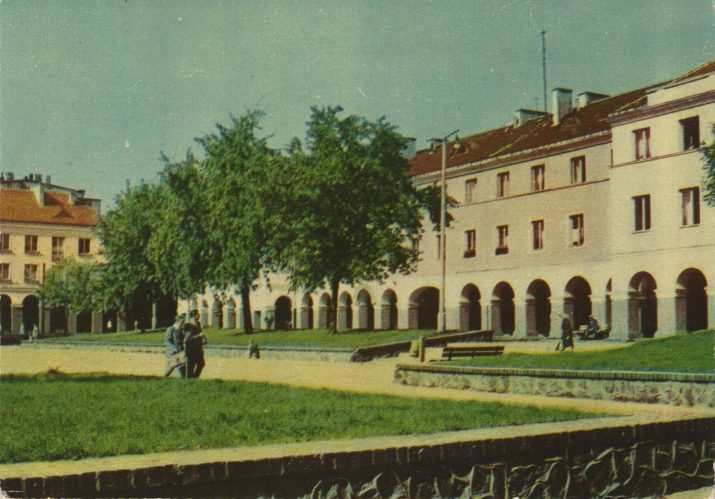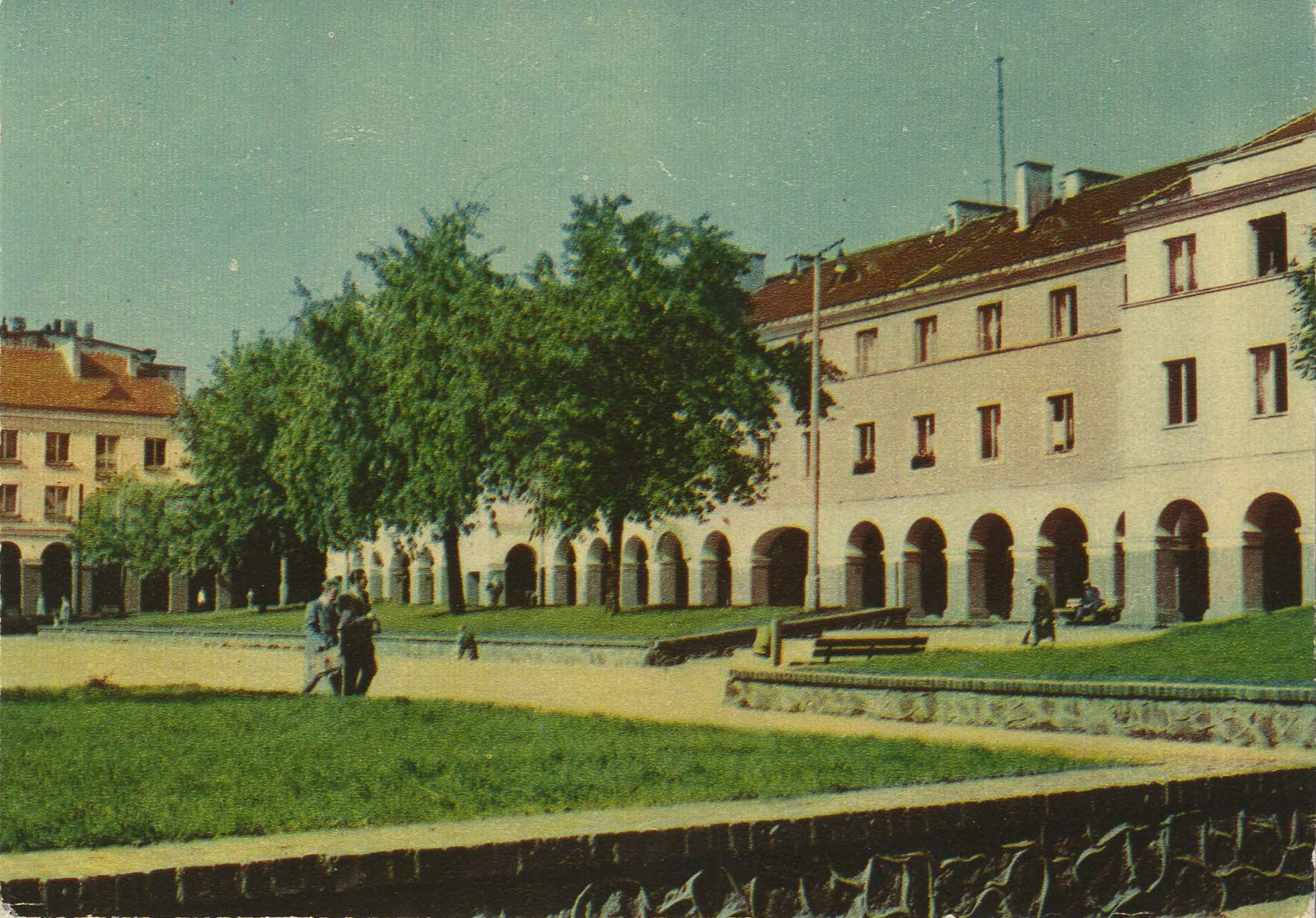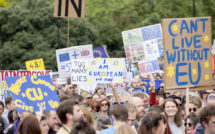

This is part of our special feature, Digitization of Memory and Politics in Eastern Europe.
In the ever-expanding universe of Facebook, it is hard to keep track of all the features of the platform. However, it is one of its most basic functions that can be of interest to those working in “history from below” in the digital age. This paper examines user reactions to digitalized postcards from two industrial cities in Poland, and investigates what users focus on and what scholars can learn from those interactions about popular approach to the past.
Facebook webpages are important platforms on which people engage with the local past. The historical images fulfil various functions: they feed nostalgia and allow people to learn about their city, but they also express critical views about the current state of local affairs. Last, but not least, they demonstrate that social media does not necessarily challenge the hegemonic discourse on history.
This paper is based on the 550 digitalized postcards found on two Facebook pages: 450 postcards from “Łódź w czasach PRL – na kartach pocztówek” [Łódź in time of the Polish People’s Republic – on postcards] dating back to 2016, and 100 images from “Stare Katowice” [Old Katowice] created in 2012. There are 6,275 users following the Katowice page and 9,463 in case of Łódź (as of 25 May 2019). [1] Both profiles are public and, thus, accessible to all Internet users. Because these are pages rather than groups, only administrators of each page decide what is displayed.
On average an image had 100 reactions (i.e. “like”, “love”, “wow”, “laugh” and “angry”), was commented 3 times and shared 14 times in case of Łódź, and for Katowice respectively had 146 reactions, 7 comments and 16 shares. There are, however, significant differences between individual posts; for example, most popular images from Katowice were “liked” 383 times, whereas the least popular ones received only 24 “likes.” In case of Łódź it spans between 254 and 20.
There are several limitations of my methodology. First of all, one cannot actually know how many people have seen a given picture, and in the vast majority of cases, there is no information about the users. Thus, one cannot be sure whether these reactions result from human activity or are automatically created by so-called bots. However, considering that these are not commercial sites, and that they don’t sell anything, such danger seems to be very unlikely. There is no guarantee of representativity and the fact that I am looking at such specific pages means that the group is preselected.
There are significant differences in the number of images from Łódź and from Katowice and furthermore, the images from Łódź have been created only after World War II. This is, however, of only small concern, as this paper focuses on users’ reactions and not for the images themselves. For the same reason, the question of how representative the images are, is of little concern to me. Having said that, the kind of image shown also influences the way it is publicly perceived. Last, but not least, the Facebook environment means that this paper reflects situations in May 2019, which might have changed since then.
Bearing all those limitations in mind, Facebook is a good place to look at when examining public history. It is by far the biggest social media platform in Poland [2] and is used by people of all social backgrounds and across the generation spectrum. [3]
Seeing past through Facebook’s eyes
One does not need to examine a huge number of images shown on both webpages to realize that certain phrases and expressions come up over and over again. And almost all the comments tend to fall into one of the five categories: (1) question regarding the location of a given scene in the city, (2) admiration for the shown past, (3) celebration of the present, (4) personal stories connected with a given place, and finally (5) “source critic.” These are not rigid categories and there are many cases of overlap, especially between personal stories and positive assessment of the past. Furthermore, the comments are not made in isolation, but often come as a reaction to what others have written in the comment section, and, for that reason, positive comments about the past or the present are the two signs of the same coin. Generally speaking, the reminiscent of the past and the celebration of the past are the most common views expressed on both webpages, whereas the appreciation of the present is the rarest.
Learning the city
The first category of comments is the most straightforward one: these are factual questions regarding the location of any given building or photographic scenery in any given urban space. Based only on publicly available information, such questions are not only posted by younger people who are, for obvious reasons, unfamiliar with the old cityscape, but also by middle-aged users.
A comment posted under a 1969 postcard from Łódź showing a furniture magazine can be an example for such a use of an old image. A simple question “[w]here was it located?” was answered by the administrator with the exact address and a matching “street view” from Google Maps. The user who asked this states on her/his profile that is originally from Łódź, lives there and works at the university there, thus we can see such inquiries are not only used by the newcomers to a given city.[4].
Such comments show interest in the changing urban landscape and examples of people learning about “their” cities and its various districts. Arguably by doing so such users also demonstrate their connection with the urban community.
Probing the image
Sometimes, such questions go much deeper, into my fifth category, namely, source critic. An example of such a question is taken again from Łódź, and was sparked by a panorama view of the city.[5] A user who states to be from the city and to live there currently, asked about a fountain, which could not be seen on the image. Was it because it did not exist at the time, or rather because of the angle of the photography? The administrator of the page picked up on this question asking others when the said fountain was constructed, but no one replied. Here we see the limitation of the learning experience on such Facebook pages, which is clearly dependent on the goodwill of other users.
Some users analyze the images themselves rather then asking for other’s opinions. For instance, the night view of Łódź prompted one user to comment that the much-admired neon signs “were good, but never all of them were switched on at the same time.”[6] Another user commented on a similar image, that the emptiness of the street, which had been noted by many users, was due to the photographic technology used back in the 1970s and did not reflect the actual volume of traffic.[7]
A card showing one of the squares in Katowice before World War I caught a lot of attention, since 240 users “liked” it, 21 shared it, and 13 commented on it as well. [8] Most of the comments referred to the beauty of the subject back then, how “elegant” this particular city square used to be, and also contrasted it with its contemporary state. These nostalgic views were challenged by one of the users, who asked if the administrators could not post an image of illegal mining shafts used by the poor [biedaszyby].
One can also find a few comments that suggest critical reflection on the source itself. Under an image of the Katowice‘s train station one user wrote: “On postcards, everything is always beautiful…”, thus suggesting the constructed nature of the depiction.[9] Sometimes looking at old images prompted users to be self-reflective: “it was amazing, because we were young.”[10] A postcard from 1955 showing an ordinary block of flat prompted one user to note: “I was always wondering about the choice of photos for postcards. Who would like to send this one from Lodz? today is a nice souvenir, but a postcard?”[11] This is a spot-on remark, especially given that the said postcard was printed only 496 times and, thus, could not have been meant for tourists.
These examples show that at least some users engage actively with the images that they are presented with; they probe the images either by adding historical information about what is shown, by directly challenging other users’ views or by putting the image in a broader context. Such source critic adapted to Facebook’s environment is an exception rather than the rule, but is important nonetheless.
Personal stories and nostalgia for the past
Some users react to historical images on emotional rather than intellectual levels. The personal reminiscences often are linked to admiration for the past and criticism of the current situation. There is a fine line between those two which is why I have grouped them together here.
Personal remarks such as “I’ve lived here,” [12] “And I was in this hospital for over three weeks” [13] or “I had fun there on my hen party,” [14] are extremely typical for this genre. There are some more elaborate entries as well: “I remember this Piotrkowska Street from my childhood, from my youth and from my dreams. Dreams because for me it was the most beautiful street in the world. I lived in Bałuty, where there were no such beautiful houses, shops and not so many people. For us, boys from Bałuty […] Piotrkowska Street was our New York, Paris, London and Berlin.” [15]
What such entries share is a very intimate experience of the urban past. It is therefore no coincidence that postcards showing ordinary urban landscapes, rather than iconic sites, are so popular among Facebook users as they speak directly to their personal lives. In this sense, postcards are arguably treated as family photos and not commodities.
As aforementioned, personal memories are sometimes linked to negative perceptions of the present. Here is an example: “It was green, there was a parking lot, a stop for taxis and even a gas station. They did what they wanted … Now there is not even a perspective to look at this object called the palace. Unless you have a drone ….” [16] The whole entry sounds bitter and the sense of loss is very strong, not least because those responsible are “them.”
It is important to stress that there are different grievances in each city, which, in the case of Łódź, is primarily the loss of trees in the streets; users from Katowice express more dissatisfaction about neglects of old buildings. This sense of loss is captured in a recurrent theme of comments along the lines: “Man, who did it bother?” [17] especially if a shown building does not exist anymore.
However, sometimes, seeing the images of the past prompts users to praise the present, for instance by stating “[n]ow it’s also beautiful” [18] or “no one mentioned the smog.” [19] Such remarks are much less pronounced. In fact, they are merely exceptions to the general rule. It is, perhaps, not that surprising, considering the preselected group of people using those two webpages.
For many users, the pages with digitalized old postcards are platforms to share their personal experiences of the particular locations in an urban landscape, but also more general memories of their home city. Some users go further and indulge in the idealized image of the past, which contrast strongly with the negatively evaluated present. There are only very few who challenge this by reminding others about less glamourous sides of the past.
Elephant in the room
Equally important is to reflect on what is not talked about on those websites. Considering that both cities were not monoethnic until 1945, there is surprisingly little said about it. In fact, it hardly was commented on. The only times that one could trace this subject, was when users referred to German street names in Katowice and views of synagogues in that city. There are two factors that might explain this. The first relates to the audience examined. Those who experienced the multicultural past of either city are likely no longer around and are even less likely typing comments on Facebook.
The second factor is that if one were to bring up such a topic, one must consider the abusive character of certain Internet groups and the nationalistic public discourse in today’s Poland. Indeed, I have come across a few hostile remarks directed at contemporary Ukrainian inhabitants of Łódź. [20]
Another topic, which is not mentioned on these sites, is the industrial past of both cities. I did not come across any comment that would directly notice that, which is not surprising if we bear in mind that neither of the two pages show many, if any industrial images. In their aesthetic, both steer in the realm of standardized, European cityscapes. It can be assumed that users who are interested in industrial imaginary are drawn to different Facebook pages or groups.
Analyzing the comments made on the images of past urban views, one should not forget what is not said nor shown. This is one of the methodological limitations of my approach, as it relies on the images selected by the administrators of each webpage. However, it is worth pointing out here that by not mentioning the issue of a multinational and industrial past, Facebook users reproduce to a large extent the current hegemonic discourse in Poland. Social media, such as Facebook, are not by default a challenge to a state’s narrative of the past.
Digital memories from below
My analysis shows that digitalized postcards posted on Facebook fulfil a few functions: they allow users to inform themselves about the history of their city, participate in the imagined urban community, share personal stories and manifest their dissatisfaction with the current state of urban affairs. The sheer number of users who share their short and long reminiscences of the past indicates that Facebook became a true agora for history from below.
Another important finding of this research is that, among the wider public, there are different approaches to historical images, some of which can be considered a valuable critic of historical sources. This makes me wonder whether such pages could not be used in historical education, thereby making people more aware of how to approach historical images. For instance, shouldn’t public institutions, such as local museums, enhance audience engagement on said platforms rather than offering traditional lectures, and, in this way, stimulate the debate by prompting relevant questions in the comment sections?
Finally, the virtual lack of comments on multicultural and industrial pasts makes one think that social media, such as Facebook, are not actually used to challenge the national narratives of the past, but rather to reproduce them. Instead of being a sphere where the hegemonic discourses are questioned, such pages are merely multiplying those historical imaginations.
Piotr Kisiel is a historian specializing in national studies and urban history. He is currently working at the University of Konstanz on a postdoctoral project on heritage in the context of urban transformation in Germany and Poland after the end of the Cold War.
[1] Ady Milman, “The Symbolic Role of Postcards in Representing a Destination Image: The Case of Alanya, Turkey,” International Journal of Hospitality & Tourism Administration 12, no. 2 (April 28, 2011): 15, https://doi.org/10.1080/15256480.2011.564495; Marion Markwick, “Postcards from Malta – Image, Consumption, Context,” Annals of Tourism Research. 28, no. 2 (2001): 418; DeBres and Sowers, “The Emergence of Standardized, Idealized, and Placeless Landscapes in Midwestern Main Street Postcards,” 140.
[2] Anon, “Global Social Media Ranking 2019,” Statista, 2019, https://www.statista.com/statistics/272014/global-social-networks-ranked-by-number-of-users/.
[3] Zosia Górska, “Polscy użytkownicy social media na koniec 2018: Messenger i Instagram rosły szybciej niż Facebook,” NapoleonCat, grudnia 2018, https://napoleoncat.com/pl/blog/polscy-uzytkownicy-social-media-na-koniec-2018-messenger-i-instagram-rosna-szybciej-niz-facebook/; Newseria.pl, “Facebook od 10 lat w Polsce. Z platformy korzysta dziś przeszło 16 mln polskich użytkowników,” Bankier.pl, May 15, 2018, https://www.bankier.pl/wiadomosc/Facebook-od-10-lat-w-Polsce-Z-platformy-korzysta-dzis-przeszlo-16-mln-polskich-uzytkownikow-7589177.html.
[4] L. Święcki, Dom Meblowy “Domus,” 1969, 1969, Łódź w czasach PRL – na kartach pocztówek, https://www.facebook.com/LodzkiePocztowkiPRL/photos/a.2004812943130549/2401297853482054/?type=3&theater.
5] T. Hermańczyk, Łódź – Fragment Miasta, 1960s, 1960s, Łódź w czasach PRL – na kartach pocztówek, https://www.facebook.com/LodzkiePocztowkiPRL/photos/a.1764653097146536/1941686222776555/?type=3&theater.
[6] J. Mucha, Ulica Piotrkowska Nocą, 1970s, 1970s, Łódź w czasach PRL – na kartach pocztówek, https://www.facebook.com/LodzkiePocztowkiPRL/photos/a.1784693351809177/2110941309184378/?type=3&theater.
[7] J. Mucha, Ulica Piotrkowska Nocą, 1979, 1979, II-3/1837/79, Łódź w czasach PRL – na kartach pocztówek, https://www.facebook.com/LodzkiePocztowkiPRL/photos/a.1784693351809177/2388586298086543/?type=3&theater.
[8] Plac Miarki, c 1912, c 1912, Stare Katowice, https://www.facebook.com/StareKatowice/photos/a.435329959894953/794173480677264/?type=3&theater.
[9] Idziemy Na Pociąg, Czy Na Mariacką?, c 1910, c 1910, Stare Katowice, https://www.facebook.com/StareKatowice/photos/a.435329959894953/873488312745780/?type=3&theater.
[10] Mucha, Ulica Piotrkowska Nocą, 1970s.
[11] Z. Flach, Nowe Osiedle Na Bałutach, 1955, 1955, 5-B-93861, Łódź w czasach PRL – na kartach pocztówek, https://www.facebook.com/LodzkiePocztowkiPRL/photos/a.1764653097146536/1807444739534038/?type=3&theater.
[12] L. Święcki, Osiedle Mieszkaniowe Im. Władysławy Bytomskiej Przy Ulicy Sporne, 1965, 1965, 28-625, Łódź w czasach PRL – na kartach pocztówek, https://www.facebook.com/LodzkiePocztowkiPRL/photos/a.1767914590153720/2154500231495152/?type=3&theater.
[13] J. Korpal, Osiedle Im. W. Bytomskiej (4 Języki), 1962, 1962, 28-350, Łódź w czasach PRL – na kartach pocztówek, https://www.facebook.com/LodzkiePocztowkiPRL/photos/a.1767914590153720/2083874048557771/?type=3&theater.
[14] S. Arczyński, Kawiarnia Przy Starym Rynku (4 Języki), 1962, 1962, 28-176, Łódź w czasach PRL – na kartach pocztówek, https://www.facebook.com/LodzkiePocztowkiPRL/photos/a.1793205190957993/2387019044909935/?type=3&theater.
[15] T. Bliński, Ulica Piotrkowska, 1971, 1971, 28-1166/III/71, Łódź w czasach PRL – na kartach pocztówek, https://www.facebook.com/LodzkiePocztowkiPRL/photos/a.1768118826799963/2008582962753547/?type=3&theater.
[16 J. Osuchowski, Gmach Prezydium WRN, 1962, 1962, 8-096, Łódź w czasach PRL – na kartach pocztówek, https://www.facebook.com/LodzkiePocztowkiPRL/photos/a.1778866865725159/2366021577009682/?type=3&theater.
[17] Pamiętacie Kamienicę, Która Stała w Miejscu Skarbka?, 1914, 1914, Stare Katowice, https://www.facebook.com/StareKatowice/photos/a.435329959894953/902808233147121/?type=3&theater.
[18] Model Katedry Na Cześć Chrystusa-Króla w Katowicach, 1927, 1927, Stare Katowice, https://www.facebook.com/StareKatowice/photos/a.435329959894953/1142727499155192/?type=3&theater.
[19] H. Poddębski, Panorama, 1940s, 1940s, B-83516, Łódź w czasach PRL – na kartach pocztówek, https://www.facebook.com/LodzkiePocztowkiPRL/photos/a.1773320246279821/2337195386558968/?type=3&theater.
[20] K. Kaczyński, Łódź-Arturówek. Dom Wypoczynkowy “Prząśniczka,” 1971, 1971, Łódź w czasach PRL – na kartach pocztówek, https://www.facebook.com/LodzkiePocztowkiPRL/photos/a.1768666783411834/2391782671100239/?type=3&theater.
Photo: Facebook
Published on September 10, 2019




